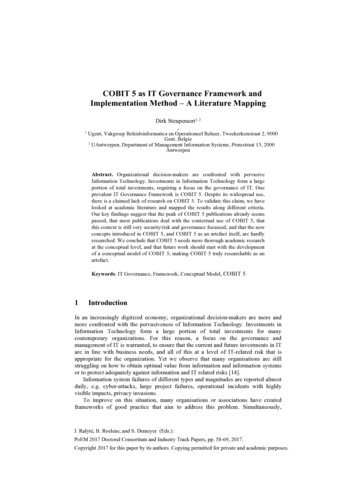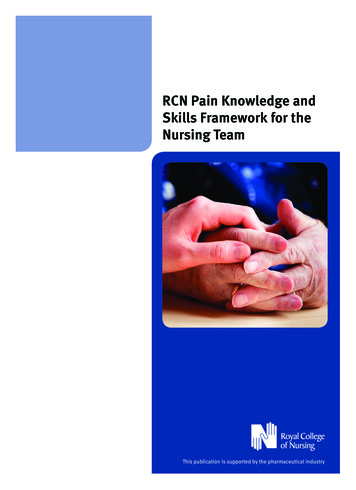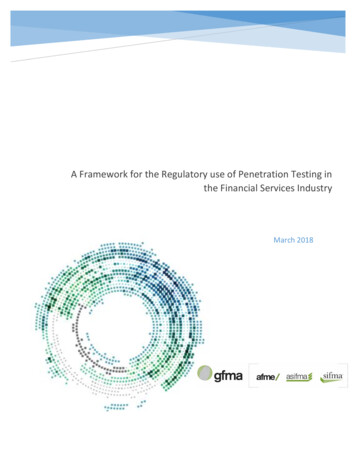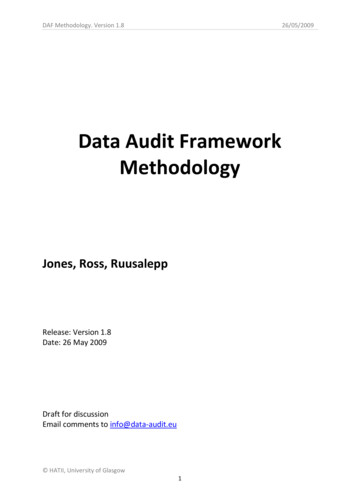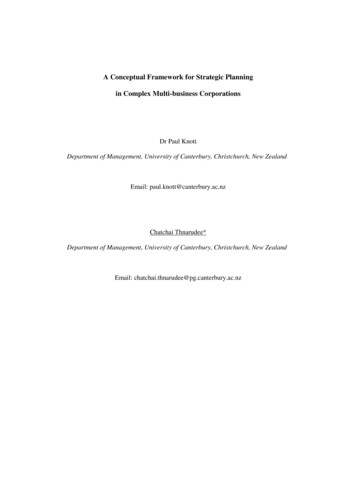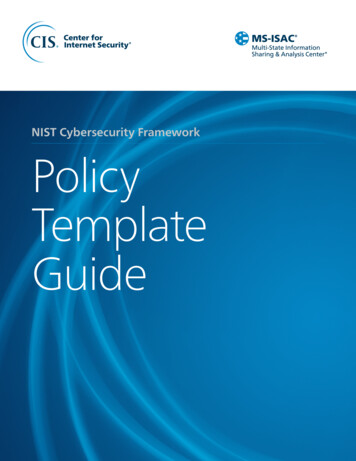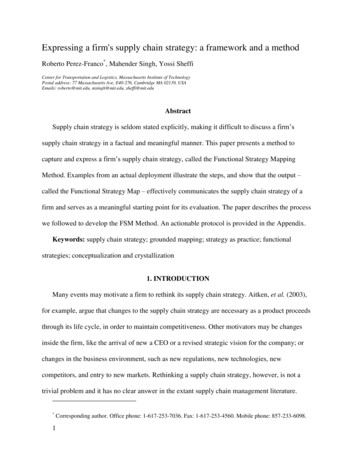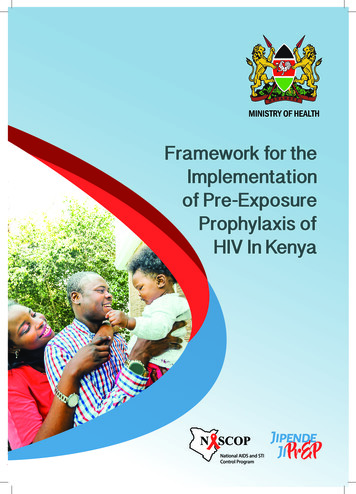
Transcription
MINISTRY OF HEALTHFramework for theImplementationof Pre-ExposureProphylaxis ofHIV In KenyaFramework for the Implementation of Pre-exposure Prophylaxis of HIV in Kenya1
National AIDS and STIControl Program NASCOP Kenya. Ministry of Health, 2017This framework is a publication of the National AIDS and STI Control Program,Ministry of Health, Kenya. You may print one copy for personal use. Bulk printingor any other of this toolkit requires written permission of NASCOP.For clarifications contact National AIDS and STI Control Program (NASCOP) on P.O.Box 19361 00202, Nairobi Kenya, Tel: 254 775597297, Email: info@nascop.or.ke,Website: www.nascop.or.keRecommended citation for this framework is:National AIDS & STI Control Programme (NASCOP), Ministry of Health, (2017).Framework for the Implementation of Pre-exposure Prophylaxis of HIV in Kenya,Nairobi, Kenya: NASCOP.ISBN-13-978-9966-038-24-12Framework for the Implementation of Pre-exposure Prophylaxis of HIV in Kenya
Table of ContentsAbbreviations and Acronyms 5Foreword 7Preface 8Acknowledgements 9Executive Summary 10Introduction 12The PrEP implementation journey in Kenya 13Situation Analysis 15Implementation Focus Areas 17Scale up plan 18Objectives 19Focus Areas 20Focus Area 1: Leadership and Governance 21Focus Area 2: Service Delivery 23Focus Area 3: Commodity Security 27Focus Area 4: Communications, Advocacy and Community Engagement30Focus Area 5: Monitoring and Evaluation 34Focus Area 6: Research and Impact Evaluation 36Focus Area 7: Financing and Resource Mobilization 42Annexes 46List of contributors 76Framework for the Implementation of Pre-exposure Prophylaxis of HIV in Kenya3
List of TablesTable 1: Summary of Roll-Out Scenarios8Table 2: PrEP Stakeholder Analysis 11Table 3: Communication Needs Assessment for PrEP21Table 4: PrEP Research Agenda 26Table 5: Five Year PrEP Financial Needs (in millions of US dollars)31Table 6: County SWOT Analysis 35Table 7: County Readiness Assessment Tool 37Table 8: Communication SWOT Analysis 41Table 9: M&E Data Collection Framework42Table 10: PrEP Summary Reporting Tool 46Table 11: PrEP Research Cost Projection 49Table 12: PrEP Research Agenda 50Table 13: Costing Assumptions 60List of FiguresFigure 1: The Vision, Goal and Mission of PrEP Implementation in Kenya12Figure 2: Phases of PrEP rollout in Kenya3Figure 3: Value Chain Analysis for PrEP 4Figure 4: Mapping of PrEP Projects in 20165Figure 5 County HIV Incidence clusters in Kenya, 20156Figure 6 Proportion of National Adult New HIV infections by Cluster, 20157Figure 7: PrEP Service Delivery Models 134Framework for the Implementation of Pre-exposure Prophylaxis of HIV in Kenya
Abbreviations and AcronymsADRAdverse Drug ReactionAGYWAdolescent Girls and Young WomenAIDSAcquired Immunodeficiency SyndromeARTAntiretroviral TherapyARVSAntiretroviral Drug(s)CDCCenters for Disease Control and PreventionCHVsCommunity Health VolunteersDHISDistrict Health Information SystemDICEsDrop In CentersEMRElectrical Medical RecordsFSWsFemale Sex WorkersGBVGender-Based ViolenceHIVHuman Immunodeficiency VirusHTSHIV Testing ServicesKASFKenya AIDS Strategic FrameworkKEMRIKenya Medical Research InstituteKEMSAKenya Medical Supplies AgencyKPKey PopulationLMISLogistics Management Information SystemM&EMonitoring and EvaluationMOHMinistry of HealthMSMMen Who Have Sex with MenNACCNational AIDS Control CouncilNASCOPNational AIDS and STI Control ProgramNEPHAKNetwork of People Living with HIV/AIDS in KenyaFramework for the Implementation of Pre-exposure Prophylaxis of HIV in Kenya5
6NHRLNational HIV Reference LaboratoryNPHLsNational Public Health LaboratoriesOPDOut Patient DepartmentPEPFARPresident’s Emergency Plan for AIDS ReliefPMTCTPrevention of Mother-To-Child TransmissionPrEPPre-Exposure ProphylaxisPPBPharmacy and Poisons BoardPWIDPeople who Inject DrugsSOPsStandard Operating ProceduresSTIsSexually Transmitted InfectionSWOTStrengths Weakness Opportunity ThreatsTDFTenofovir Disoproxil FumarateTWGTechnical Working GroupUSAIDUnited States Agency for International DevelopmentVMMCVoluntary Medical Male CircumcisionWHOWorld Health OrganizationFramework for the Implementation of Pre-exposure Prophylaxis of HIV in Kenya
ForewordKenya has made significant progress in the reduction of new HIV infections inthe past decade through the scale up of HIV prevention programs. In addition,access to HIV treatment by over 1 million Kenyans has improved the quality of lifeof adults and children living with HIV. Despite this progress, an estimated 77648Kenyans got infected with HIV in 2015. Half of these were young people aged 1524 with young women bearing a third of all new infections.As we expand the HIV treatment program, the war on the HIV epidemic may notbe won until we reduce the rate of new HIV infections. This can only be donethrough greater investment in HIV prevention programs that will ensure those whoare not HIV infected are kept uninfected. The Ministry of Health is now introducingPre-Exposure Prophylaxis (PrEP) of HIV as an addition to existing HIV preventioninterventions such as HIV Testing Services, Risk reduction counselling, VoluntaryMedical Male Circumcision, Condoms and Elimination of Mother to ChildTransmission. It adds impetus to the existing HIV prevention program to propel thecountry towards achieving the goal of eliminating new HIV infections by 2030.This can only be realized by all players working towards this common goal.Working with counties to deliver health services to the people as well as enhancedpartnerships with the community, people living with HIV, health providers,academic and research institutions, implementing partners and the all key actorswe will deliver on our commitment to eliminate new HIV infections in Kenya by2030.It is my hope that this framework will provide guidance and impetus to all Kenyanstowards eliminating transmission of HIV in every part of this country.Dr. Jackson KiokoDirector of Medical Services,Ministry of Health, KenyaFramework for the Implementation of Pre-exposure Prophylaxis of HIV in Kenya7
PrefaceThis framework for implementation of Pre-exposure prophylaxis (PrEP) for HIVin Kenya aims to provide guidance on the roll out of PrEP in Kenya. The targetaudience include policy makers, national and county governments, healthprogram managers, regulatory authorities, health providers, potential PrEP usersand the general population.Kenya has been in the forefront of providing evidence on the efficacy, safety andfeasibility of PrEP locally, regionally and globally, and uses this evidence as wellas international evidence in the design of the program. It utilizes an evidenceinformed approach to geographical prioritization and combination in line withthe Kenya AIDS Strategic Framework (KASF) and Kenya HIV Prevention Revolutionroadmap. This is presented as roll out scenarios and a 5-year scale up plan forPrEP in Kenya from 2017 to 2022. It outlines the service delivery models for PrEP,measures to ensure commodity security and includes a Monitoring and EvaluationFramework to measure progress.The success of this program is underpinned by the communication and advocacyplan which has been well informed by previous demonstration projects andfeasibility studies on PrEP roll out in Kenya. It proposes innovative communicationand robust community engagement approaches to reach the target audiences.This framework adopts an implementation science approach with learningsincorporated in the programming to inform changes in policies or strategies asoutlined in the research plan. It also estimates the resources needed and the planto finance this intervention program.It has been developed through consultations with researchers, policy makersat national and county level, and key actors including the religious groups, theprivate sector players, the community and more importantly the potential PrEPusers.The process of development of this framework was spearheaded by the PrEPTechnical working group led by NASCOP and comprising experts from NASCOP,NACC, PEPFAR, World Health Organization (WHO), UN Programme of HIV/AIDS(UNAIDS), International AIDS Vaccine Initiative (IAVI), Kenya Medical researchInstitute (KEMRI), Jilinde Project, LVCT Health, CHAI, Partners PrEP Scale-upProject, Pharmaceutical Society of Kenya, Kenyatta National Hospital, University ofNairobi and Network of People Living with HIV/AIDS in Kenya (NEPHAK). I wishto appreciate the time, effort and dedication of these experts from the variousinstitutions represented who worked under the leadership of Ministry of Healththrough NASCOP.8Framework for the Implementation of Pre-exposure Prophylaxis of HIV in Kenya
AcknowledgementsThis framework is drawn from contributions technical experts from differentorganizations across the country and internationally.We wish to thank the National AIDS and STI Control Programme led multi-partnerstechnical working group that steered the consultations at the national and countylevel including potential PrEP users to develop this framework.We thank the following institutions for technical and financial support during thedevelopment of this framework: Ministry of Health (NASCOP, NACC)Bill and Melinda Gates FoundationPEPFARJoint UN team (WHO,UNAIDS)Jilinde Project partners led by JHPIEGOLVCT Health and OPTIONS Consortium PartnersPartners PrEP Scale Up Project (University of Washington & KEMRI)Clinton Health Access Initiative (CHAI)Global Evaluation of Microbicide Sensitivity (GEMS), University of PittsburghKenya Medical Research Institute (KEMRI)Network of People living withKenyatta National Referral HospitalUniversity of NairobiInternational AIDS and Vaccine initiative (IAVI)Special thanks to agencies that were involved in demonstration projects thatprovided evidence to inform scale up of PrEP in Kenya.I also wish to acknowledge and appreciate the core writing team lead by Dr SarahMasyuko of NASCOP, and included Olivia Ruturi, Phillip Muchiri, Tom Marwa, Dr.Elizabeth Irungu, Dr. Michael Kiragu, Patriciah Jeckonia, Jordan Kyongo, Dr Mecha,Precious Otieno, Joel Mutinda who have worked tirelessly to make this a reality.Special compliments go to all the chairs and co-chairs of technical working groupcommittees. To all individuals who participated in this exercise, your contributionsare highly appreciated.Dr Martin Sirengo,Head, National AIDS and STI Control ProgramFramework for the Implementation of Pre-exposure Prophylaxis of HIV in Kenya9
Executive SummaryIn 2015, the World Health Organization (WHO) released a series ofrecommendations supporting the use of Tenofovir containing drugs as preexposure prophylaxis (PrEP) to prevent the acquisition of HIV.1 In July 2016, Kenyalaunched the new Guidelines on Use of Antiretroviral Drugs for Treatment andPrevention of HIV Infection, which recommended the immediate initiation ontoART and the provision of PrEP to all those at substantial ongoing risk of acquiringHIV infection2.Focus Areas for PrEPImplementation Leadership and governance Service delivery Commodity security Communication, advocacy andcommunity engagementThere is limited PrEP implementationexperience in the context of developingcountries, Kenya has had the opportunity tobe part of 2 clinical trials and 2 demonstrationprojects from which the evidence generateduniquely positioned Kenya as an early adopterfor the delivery of PrEP within the publichealth system.This framework has adopted animplementation science approach, providing Monitoring and Evaluationguidance on PrEP implementation at scaleto policy-makers, national and county Research and Impactgovernments, health program managers,Evaluationimplementing partners, service providers, Resource Mobilization andpotential PrEP users and the generalFinancing.population. This framework has been writtenwith the recognition that the delivery of oralPrEP at scale will inform the delivery of other upcoming HIV PrEP products likevaginal rings, Long acting injectable & vaccines.Oral PrEP delivery will inform programs on how (where) to do effective delivery ofHIV prevention among HIV-1 negative at risk that require longitudinal services.The framework views the delivery of PrEP in seven focus areas that will ensure acomprehensive approach to implementation. The focus areas identified within theframework aim to address the availability, acceptability, accessibility of PrEP andthe holistic integration into the national HIV combination prevention strategy, withthe goal of reducing HIV in Kenya.101World Health Organization (WHO). WHO Expands Recommendation on Oral Pre-Exposure Prophylaxis of HIV Infection (PrEP).2015. Geneva: WHO2National AIDS and STI Control Programme (NASCOP). Guidelines on Use of Antiretroviral Drugs for Treating and PreventingHIV infection in Kenya 2016. Nairobi, Kenya: NASCOP, July 2016. PrintFramework for the Implementation of Pre-exposure Prophylaxis of HIV in Kenya
Within the appendix of this framework are supporting documents including aPrEP service delivery toolkit, training packages for service providers and peereducators, a communication and advocacy plan, a research plan and monitoringand evaluation tools.Figure 1: The Vision, Goal and Mission of PrEP Implementation in KenyaVISIONZero new HIVinfections in KenyaVISIONGOALMISSIONGOALContribute to ending the AIDSepidemic and achieving vision by2030 through universal access tocomprehensive and highly effectiveHIV preventionMISSIONTo provide sustainable access to safe,affordable and quality PrEP services incombination with other HIVprevention interventionsFramework for the Implementation of Pre-exposure Prophylaxis of HIV in Kenya11
IntroductionPre-exposure Prophylaxis (PrEP) is a form of HIV prevention in which a HIV negativeperson at high
Kenya Medical Research Institute (KEMRI) Network of People living with Kenyatta National Referral Hospital University of Nairobi International AIDS and Vaccine initiative (IAVI) Special thanks to agencies that were involved in demonstration projects that provided evidence to inform scale up of PrEP in Kenya. I also wish to acknowledge and appreciate the core writing team .

